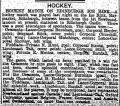Edinburgh Hockey (1915): Difference between revisions
(Created page with "During World War I, soldiers from Newfoundland were sent to Britain in the fall of 1914. They were initially stationed in Salisbury, Plain, England, for training, befo...") |
|||
| Line 18: | Line 18: | ||
Scotsman 3-13-15.png|The March 13, 1915, edition of ''The Scotsman''. | Scotsman 3-13-15.png|The March 13, 1915, edition of ''The Scotsman''. | ||
Edinburgh Evening News 3-20-15.png|The March 20, 1915, edition of the ''Edinburgh Evening News''. | Edinburgh Evening News 3-20-15.png|The March 20, 1915, edition of the ''Edinburgh Evening News''. | ||
Daily Star 4-19-15. | Daily Star 4-19-15.jpg|The April 19, 1915, edition of the ''St. John's Daily Star''. | ||
</gallery> | </gallery> | ||
Latest revision as of 10:47, 12 December 2016
During World War I, soldiers from Newfoundland were sent to Britain in the fall of 1914. They were initially stationed in Salisbury, Plain, England, for training, before being transferred to Fort George, Inverness, Scotland, on December 7. Between February and April 1915, the 1st Newfoundland Regiment (also called the "Blue Puttees" for their unusual uniforms) played hockey games at the Haymarket Ice Rink in Edinburgh, Scotland, while stationed at the Edinburgh Castle for training.
A report from the St. John's Evening Telegram on January 18, 1915, noted the following: "The Newfoundland Hockey League have cabled Lieutenant Tait at Fort George (Scotland) to get a set of hockey uniforms at the expense of the league. It looks as if there is some chance of ice hockey in Northern Scotland."
The first game took place in late February between two selected sides of the regiment - known quite simply as the "first" and "second" teams. The rosters were as follows: First team- N. Hunt, C.Q.M.S. Strong, Lieut. R.H. Tait, E. Munn, Corporal Churchill, E. Winter and Corporal Rendell. Second team- L.C. Burnham, Corporal Herder, L.C. Woods, R. Herder, L.C. Shortall, L.C. Hutchings, and W. Grant. The match was played with seven players aside, and Lieutenant Randall served as the umpire (official). The game ended in a 1-1 tie. The players delighted the crowd by saluting their opponents with three cheers.
Another match was played on March 12, again involving two regiment teams, this time called the "Crescents" and the "Fieldians". These were the team rosters: Crescents- Lance-Corporal Burnham, goal; Corporal Herder, point; Sergeant Stick, cover point; Corporal Churchill, right wing; Lance-Corporal Hutchings, centre; Lance-Corporal Shortaw, left wing. Fieldians- Private N. Hunt, goal; Corporal Strong, point; Lieutenant Tait, cover point; Lance Corporal Stick, right wing; Private E. Mutter, centre; Corporal Randall, left wing. The game lasted an hour and ended in a 9-8 victory for the Crescents. Lieutenant Randall again served as the referee. Burnham, Churchill, and Herder were noted as excelling for the Crescents, while Tait and Stick of the Fieldians were also praised for their play.
Eight days later, on March 20, a game was organized between the Newfoundland Regiment and a team of Canadian students from Edinburgh University. These were the teams: Canadians- Dr Tlatt, Toronto; W.R. Thomson, St John, N.B.; T.B. Eaton, Acadia; D.H. Paterson, Winnipeg; E.W. Grant, Halifax; J.W. Lament, Winnipeg; C. Harris, Sackville. Newfoundlanders- Lance-Corporal Burnham, Corporal Herder, Lance-Corporal Stick, Lieutenant Tait, Private R. Herder, Corporal F.H. Churchill, Sergeant Stick. The game was dominated by the Newfoundlanders, who won 14-0. Newfoundland and Canada faced each other again on April 19, and the result was an even more lopsided 15-0 win for the former side.
It should be noted that the rink had no side boards, and when players got knocked down by body-checks while at the periphery of the ice surface, they fell into a garden that was adjacent to the ice surface. During the Newfoundland-Canada game on March 20, the tea garden was all-but destroyed by the abuse it received from falling players. There was also a statue of Venus de Milo at the rink, who some of the players joked was rendered armless due to being struck by airborne pucks.
The Newfoundland Regiment was later sent to Egypt, before landing on the Gallipoli peninsula in Turkey on September 20, 1915. The regiment fought alongside the 29th Division of the British Army at Gallipoli. There was little hockey played at the Edinburgh rink after the departure of the Newfoundlanders, and the first team from the city to join the Scottish National League was the Edinburgh Royals in 1952.


